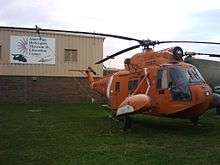American Helicopter Museum
The American Helicopter Museum & Education Center (AHMEC) is located at 1220 American Boulevard, West Chester, Pennsylvania, United States. The transport museum focuses on the history, science and technology of rotary wing aviation.[2] The collection contains over 40 civilian and military, autogyros, convertiplanes and helicopters, including some early generation models.[2] The museum also has an extensive research library, the Renzo Pierpaoli Memorial Library,[2] which contains documents, artifacts, films, and memoirs that museum members can use.
 | |

| |
| Established | October 1996[1] |
|---|---|
| Location | 1220 American Boulevard West Chester, Pennsylvania, United States |
| Coordinates | 39.992°N 75.579°W |
| Type | Aviation and History[2] |
| Visitors | 30,000[3] |
| Founder | Bob Beggs and Peter Wright Sr. |
| Director | Sarah M. Sands |
| Public transit access | SEPTA Route 92[4] |
| Website | www.americanhelicopter.museum |
The museum strives to restore and display historic aircraft and chronicle the origin and development of rotary wing aircraft. The museum's exhibits chronicle the efforts of pioneers like Harold Frederick Pitcairn, Mr. W. Wallace Kellett of Kellett Autogiro, Arthur M. Young and Frank Piasecki, and today it continues to record the new and ever expanding role of the U.S. helicopter industry. The exhibits span the history of rotary wing aircraft from the earliest rotorcraft to the latest developments in tiltrotors, and AHMEC is one of only two museums in the world currently displaying a V-22 Osprey.
History
The American Helicopter Museum & Education Center opened to the public in October 1996 to serve as a "lasting tribute to those men and women who pioneered the development of rotary wing aircraft" and to encourage future generations of aviation pioneers.[5]
According to the website, no one person has played more of an important role in the founding and building of the American Helicopter Museum & Education Center than distinguished aviator Peter Wright. A celebrated veteran of the famed Flying Tigers (1941–42), and founder of Keystone Helicopter Corporation (which was acquired in 2005 by Sikorsky Aircraft Corporation), He was also the sales manager of the world's first commercial helicopter operator, Helicopter Air Transport.[6] Mr. Wright is considered a pioneer of the commercial helicopter industry. He has been the recipient of numerous awards and honors including the Distinguished Flying Cross. Largely because of his vision, his devotion to the cause and his unceasing efforts the American Helicopter Museum & Education Center became a reality in 1996.
The continuation of the museum as a showcase for the helicopter industry and as an important and viable institution was solidified in 2003 when the Robinson Helicopter Company generously endowed it with a gift of $1 million.[5]
Programs
Each year the Museum hosts thousands of visitors, school groups, families and senior citizens. Tourists of all ages from the U.S and abroad come here to witness the history and the future of the helicopter.
- Stubby, the educational traveling helicopter.
Stubby is an interactive helicopter that travels to schools, camps and community events. Docents accompanying Stubby give kids a chance to sit in the cockpit, operate the controls and learn how each works. Students also learn about the hand-eye co-ordination necessary to fly a helicopter.[5] Stubby is a Hughes TH-55A Osage that has shortened rotor blades and tail boom to facilitate transport. It was acquired by the museum in 1998.
- Women in Aerospace Technology Program
According to a brochure,[2] the Women in Aerospace and Technology, Diversity Project engages young girls to look toward science and technology in fun and exciting ways and to mentor and encourage their future career and growth opportunities in technology.
It is a collaborative effort between the American Helicopter Museum & Education Center, the Girl Scouts of Eastern Pennsylvania, Boeing Rotorcraft Systems, Sikorsky Global Helicopters, the Physics Department at Penn State University, the Physics Departments at West Chester University, Drexel University, as well as other industry and educational partners.
The curriculum and guidelines are developed and taught by industry partners and stratified for appropriate age groups. The project focuses and channels the interests of grade 4 to 12 girls in the areas of engineering, computer programming, aerospace technologies, math, and flight. The initial focus of the program is four categories related to Aerospace: The Physics of Flight, Rotorcraft Design, Decreasing Size and Computerization of Controls, and Robotic Flight.
- Aerospace Boot Camp
AeroCamp is a two-day aviation themed camp for kids ages 8–12. The museums has five separate camp sessions to choose from. Children learn the fundamentals of flight and aircraft design, build and fly their own gliders, pilot a flight in the museums flight simulator among other skills.
- Ground School Boot Camp
Ground School Boot Camp is a one-week camp for students ages 12–17 which will serve as the beginning of their helicopter flight training. By the end of the week, each student will have accumulated 35 total hours of ground school from a certified flight instructor and will be logged and signed in their pilot logbook. Ground School Boot Camp is given classroom/lecture style which ground school is most commonly given, along with utilizing the museums exhibits and working helicopters for a hands-on experience and better understanding of lessons. Lessons include helicopter aerodynamics, airport operations, radio calls, weather, helicopter maneuvers, approaches and takeoffs, pilot certification process, navigation, aeronautical charts, and airspace, among others.
Aircraft on display

Notable Interior Displays
- Bell 47D-1 / H-13D Sioux
- Bell TH-IL Huey.
- Boeing HH-47 CSAR-X (Mockup)
- Hughes MD 530F / MH-6J Little Bird.
- Hughes 369 (OH-6 / OH-6A) Cayuse.
- Piasecki PV-14 / HUP-2 Retriever.
Exterior Displays
- Kaman K-20 / HH-2D Seasprite.
- Piasecki H-21 / CH-21B Workhorse.
- Sikorsky S-61 / HH-3 Sea King.
- Sikorsky S-62 / HH-52 Sea Guardian
- V-22 Osprey prototype on display as an example of a military tiltrotor.[7]
See also
- Fly-in
- Flypast
- List of aerospace museums
- List of air show accidents and incidents
- List of air shows
References
- Helicoptermuseum-History Retrieved 2011-09-18
- American Helicopter Museum & Education Center. "American Helicopter Museum & Education Center" brochure, circa 2007.
- "American Helicopter Museum". Philadelphia Pass. Archived from the original on 23 October 2012. Retrieved 2 April 2013.
- "SEPTA.org | Service Information". www4.septa.org. Retrieved Apr 27, 2020.
- American Helicopter Museum & Education Center. "http://www.helicoptermuseum.org/RotorFest/RotorFestInformation.aspx"
- Sims, Gayle Ronan. "Peter Wright Sr., 90, a pioneer in helicopters". The Philadelphia Enquirer. Retrieved 28 March 2020.
- Aircraft on display Archived 2015-02-07 at the Wayback Machine. helicoptermuseum.org
External links
| Wikimedia Commons has media related to American Helicopter Museum. |
- American Helicopter Museum & Education Center official website
- Photos of helicopters and rotorcraft at the American Helicopter Museum
- Rotorfest page at David Schultz Airshows
- Rotorfest at Helicopter Association International
